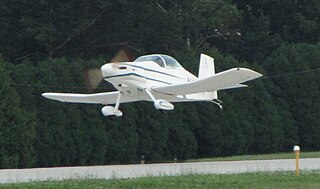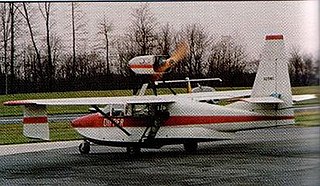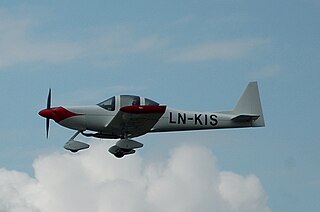
The Piper PA-28 Cherokee is a family of two-seat or four-seat light aircraft built by Piper Aircraft and designed for flight training, air taxi and personal use. The PA-28 family of aircraft comprises all-metal, unpressurized, single piston-engined airplanes with low-mounted wings and tricycle landing gear. They have a single door on the right side, which is entered by stepping on the wing.

Lancair International, Inc. is a U.S. manufacturer of general aviation aircraft kits. They are well known for their series of high-performance single-engine aircraft that offer cruise speeds that surpass many twin-engine turboprop designs. Along with the Glasair series, the early Lancair designs were among the first kitplanes to bring modern molded composites construction to light aircraft.

The Barrows Bearhawk, now also called the Bearhawk 4-Place, is an American amateur-built aircraft, designed by Bob Barrows and produced by R&B Aircraft of Fincastle, Virginia, AviPro Aircraft and now Bearhawk Aircraft of Austin, Texas. The aircraft is supplied as a kit or as plans for amateur construction.

The Thorp T-18 is an American, two-place, all-metal, plans-built, homebuilt aircraft designed in 1963 by John Thorp.

The Piper PA-34 Seneca is a twin-engined light aircraft, produced in the United States by Piper Aircraft. It has been in non-continuous production since 1971. The Seneca is primarily used for personal and business flying.

The Lancair Legacy, a modernized version of the Lancair 320, is a low-wing two-place retractable-gear composite monoplane manufactured by the American company Lancair. It is available as a kit that cost US$71,500 in 2011. There is also a fixed-gear version, the Legacy FG. The retractable version of the Legacy cruises at 276 mph at 8,000 ft and the fixed gear version cruises at 215 mph.

The Partenavia P.64B/P.66B Oscar is an Italian two/four-seat, single-engined, high-wing monoplane built by Partenavia.

The Lancair 360 is a two-seat aircraft marketed in kit form. It is a low-wing monoplane of conventional configuration with retractable tricycle undercarriage. The Lancair Legacy was chosen to replace the Lancair 360 in 1999.

The AS/SA 202 Bravo is a two to three-seat civil light aircraft jointly designed and manufactured by the Swiss company Flug- und Fahrzeugwerke Altenrhein (FFA) and the Italian company Savoia-Marchetti. The aircraft was designated the AS 202 in Switzerland, and the SA 202 in Italy.

The Jurca MJ-5 Sirocco is a two-seat sport aircraft designed in France in the early 1960s and marketed for homebuilding. It is one of many wooden homebuilt designs from Romanian born designer Marcel Jurca. Jurca, a Henschel Hs 129 pilot in World War II marketed the plans in Canada and America through Falconar Aviation. It is a low-wing cantilever monoplane of conventional configuration and wooden construction throughout. The tandem seats are enclosed by a bubble canopy, and the tailwheel undercarriage can be built as either fixed or with retractable main units. Marcel Jurca died on 19 October 2001, at which time plans were still available from the designer's website.
The Jurca MJ-51 Sperocco is a plans-built two-seat tandem aerobatic aircraft derived from the Jurca MJ-5 Sirocco.

The Wag-Aero CUBy is a replica of the Piper J-3, designed by Dick Wagner and marketed by Wag-Aero of Lyons, Wisconsin as plans or in kit form.

The Dream Tundra is a robust, single-engine, high-wing monoplane designed in Canada. Seating four, its short takeoff and landing characteristics can be adapted to land, snow, or water use. It is produced as a kit for homebuilding.

The Glasair GlaStar is an American amateur-built aircraft that was designed by Tom Hamilton and produced by Stoddard-Hamilton Aircraft and later Glasair Aviation. It was first flown in 1994 and was superseded in production by the Glasair Sportsman 2+2 c. 2005. When it was available the aircraft was supplied as a kit for amateur construction.
The Peña Joker and Super Joker are a family of French amateur-built aircraft that were designed by Louis Peña of Dax, Landes and are made available in the form of plans for amateur construction.
The Pro-Composites Vision is an American amateur-built aircraft, designed by Steve Rahm and produced by Pro-Composites of Buffalo Grove, Illinois. The aircraft is supplied in the form of plans for amateur construction, with some pre-formed parts made available to speed construction.

The Rihn DR-107 One Design is an American aerobatic homebuilt aircraft that was designed by Dan Rihn and first flown in 1993. The aircraft is supplied by Aircraft Spruce & Specialty of Corona, California in the form of plans and a materials kit for amateur construction.
The CEI Free Spirit Mk II, also called the Cabrinha Free Spirit Mark II and the Cabrinha Model 423, is a three-seat American homebuilt aircraft that was designed by Richard Cabrinha and produced by CEI of Auburn, California, introduced at AirVenture in 1995. The aircraft was intended to be supplied as a kit for amateur construction, but only prototypes seem to have been completed.

The Collins Dipper was an American homebuilt flying boat that was designed and produced by Collins Aero of Chadds Ford, Pennsylvania and first flown in 1982. The aircraft was supplied in the form of plans for amateur construction. Only one was built and none remain registered.

The Tri-R KIS TR-1 is an American homebuilt aircraft that was designed by Rich Trickel and produced by Tri-R Technologies of Oxnard, California, introduced in the 1990s. When it was available the aircraft was supplied as a kit for amateur construction.




















